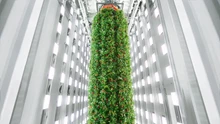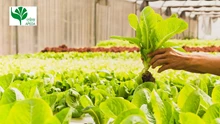
The poplars may be the first genetically modified trees planted outside of a research trial or a commercial fruit orchard in the United States. The trees are intended to be a large-scale solution to climate change by Living Carbon, a San Francisco-based biotechnology company that created them.
"People have told us it's impossible," Maddie Hall, the company's co-founder and CEO, said of her dream to use genetic engineering to help the environment. But she and her colleagues have also found believers, with $36 million invested in the four-year-old company. The company has also received criticism. An environmental group, the Global Justice Ecology Project, has called the company's trees "growing threats" to forests and expressed concern that the federal government allowed them to evade regulation, opening the door to commercial plantings much sooner than is typical for engineered plants. Living Carbon has yet to publish peer-reviewed papers; its only publicly reported results are from a short-term greenhouse trial. Some experts are intrigued by the data, but they are far from convinced.
"They have some encouraging results," said Donald Ort, a geneticist at the University of Illinois whose plant experiments inspired Living Carbon's technology. However, he added that the idea that greenhouse results will translate into real-world success is "not a slam dunk."
Biologists experiment with how the trees perform photosynthesis, the chemical reactions that plants use to convert sunlight, water, and carbon dioxide into sugars and starches. In doing so, they are following in the footsteps of evolution: Several times throughout Earth's long history, advances in photosynthesis have allowed plants to consume enough carbon dioxide to significantly cool the planet.
While photosynthesis has a significant impact on the Earth, it is far from perfect as a chemical process. Plants are unable to capture and store more than a small fraction of the solar energy that falls on their leaves due to a variety of inefficiencies. These inefficiencies, among other things, limit the rate at which trees and other plants grow and the amount of carbon dioxide they absorb.
Scientists have worked for decades to pick up where evolution left off. Ort and his colleagues announced in 2019 that they had genetically modified tobacco plants to better photosynthesize. Photosynthesis normally generates a toxic byproduct that a plant must dispose of, wasting energy. The Illinois researchers used pumpkin and green algae genes to induce tobacco seedlings to recycle toxins into more sugars, resulting in plants that were nearly 40% larger.
That same year, Hall met her future co-founder Patrick Mellor at a climate tech conference after working for Silicon Valley startups like OpenAI (which was responsible for the language model ChatGPT). Mellor was investigating whether trees could be genetically modified to produce decay-resistant wood.
Yumin Tao, a synthetic biologist who previously worked for the chemical company DuPont, was hired. Ort's genetic hack for poplar trees was retooled by him and others. Living Carbon then cultivated engineered poplar clones in pots. Last year, the company reported in a paper that has yet to be peer reviewed that its modified poplars grew more than 50% faster than non-modified poplars in the greenhouse over five months. The greenhouse-tested trees were created by the company's researchers using a bacterium that splices foreign DNA into the genome of another organism. However, for the trees planted in Georgia, they used an older and cruder technique known as the gene gun method, which essentially blasts foreign genes into the chromosomes of the trees.
Living Carbon has moved quickly and freely in a field accustomed to glacial progress and heavy regulation. The gene gun-modified poplars avoided a set of federal genetically modified organism regulations that can stymie biotech projects for years. (Those rules have since been changed.) In contrast, a team of scientists who used the same bacterium method used by Living Carbon to genetically engineer a blight-resistant chestnut tree has been waiting for a decision since 2020. It took several years for Washington state to approve an engineered apple grown on a small scale.
Unlike fast-growing pines, hardwoods that grow in bottomlands like these produce wood so slowly that a landowner may only get one harvest in a lifetime, according to Stanley. He hopes that Living Carbon's "elite seedlings" will enable him to grow bottomland trees and earn money more quickly. "We're taking a 50 to 60-year timber rotation and cutting it in half," he explained. "It's a win-win situation."
Forest geneticists were less optimistic about the trees in Living Carbon. According to Andrew Newhouse, director of the engineered chestnut project at SUNY College of Environmental Science and Forestry, researchers typically evaluate trees in confined field trials before moving on to large-scale plantings. "Based on very limited real-world data, their claims appear bold," he said.
The United States Forest Service, which plants millions of trees each year, has said little about whether it will use engineered trees. To be considered for planting in national forests, which account for nearly one-fifth of all forestland in the United States, Living Carbon's trees would need to align with existing management plans, which typically prioritise forest health and diversity over reducing atmospheric carbon levels, according to Dana Nelson, a geneticist with the service. "It's difficult for me to imagine it fitting on a national forest," Nelson said.
For the time being, Living Carbon is concentrating on private land, where it will face fewer obstacles. It plans to plant poplars on abandoned coal mines in Pennsylvania later this spring. By next year, Hall and Mellor hope to have planted millions of trees.
(Source: New York Times)










